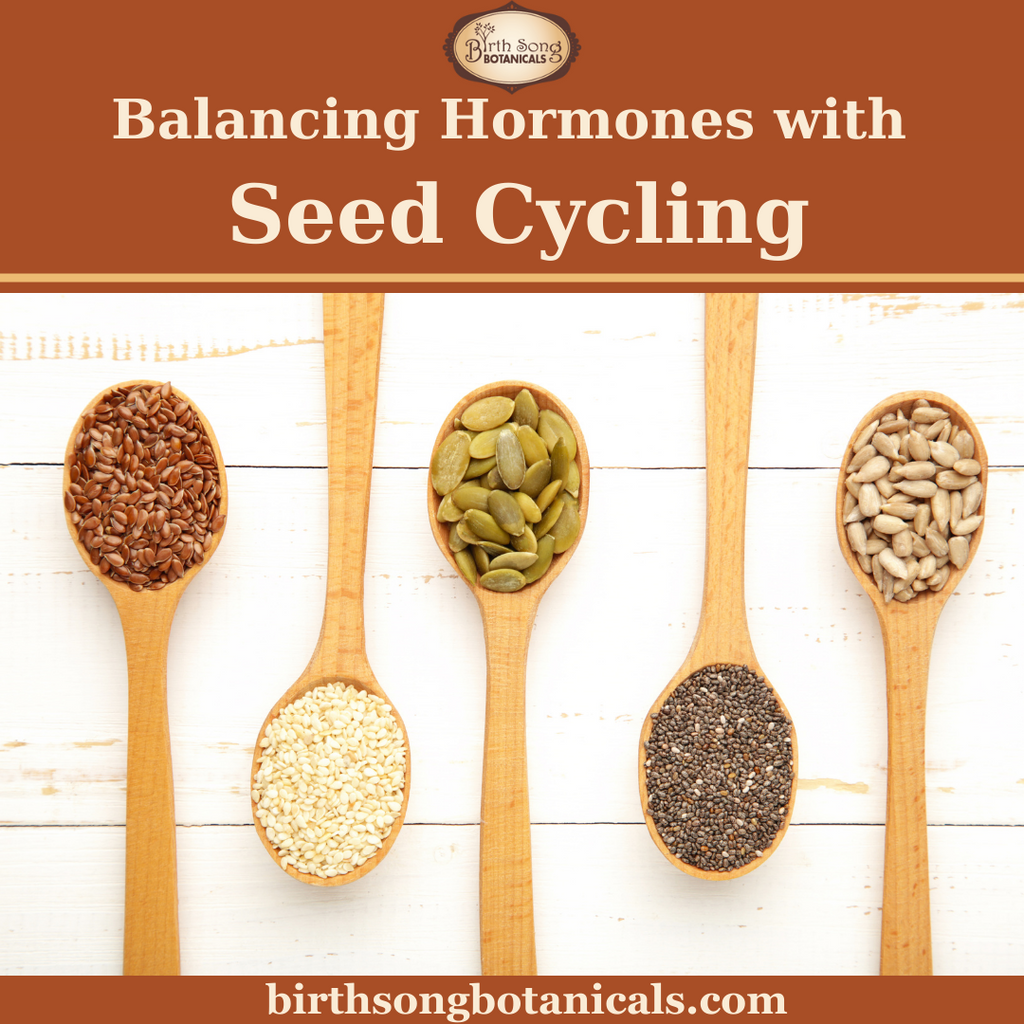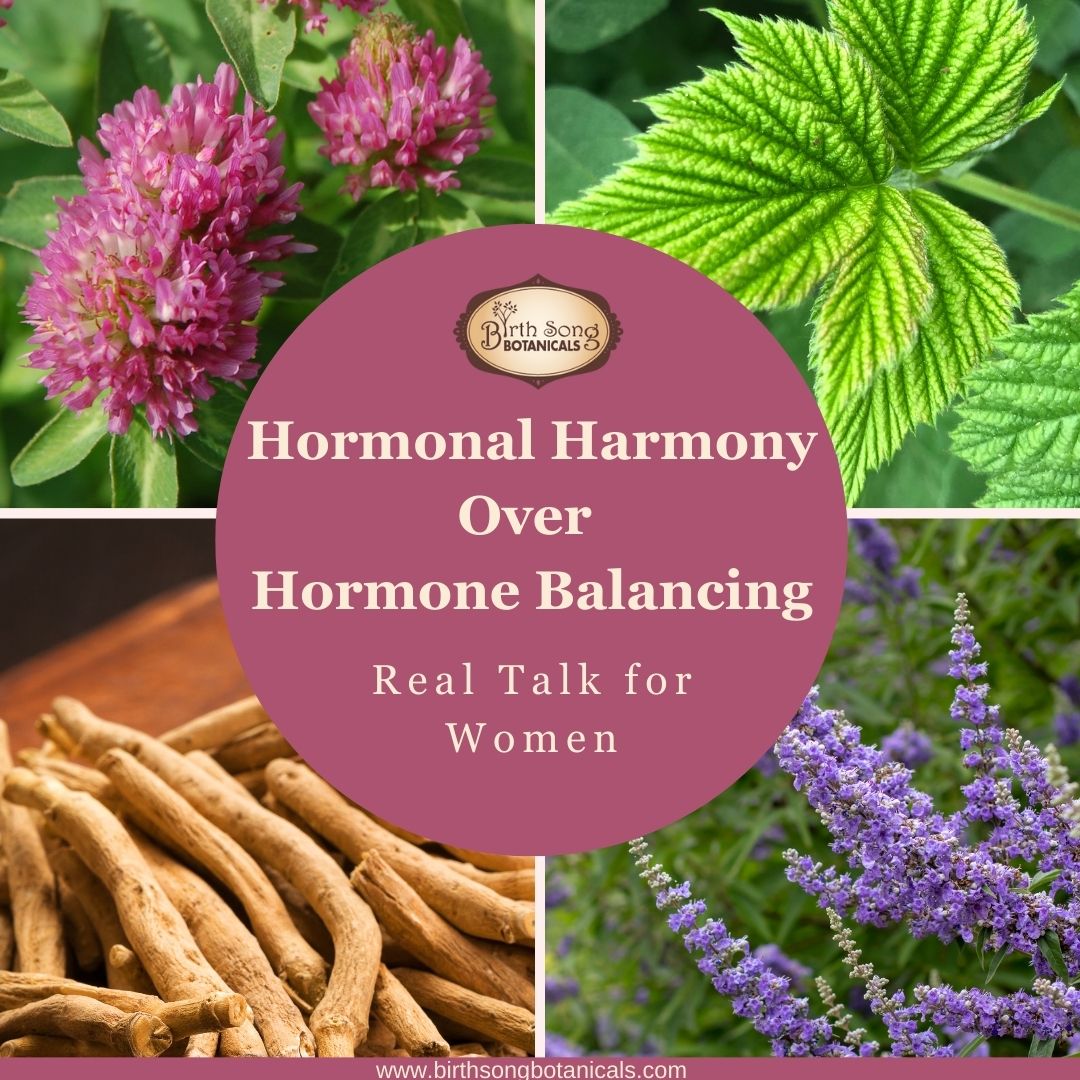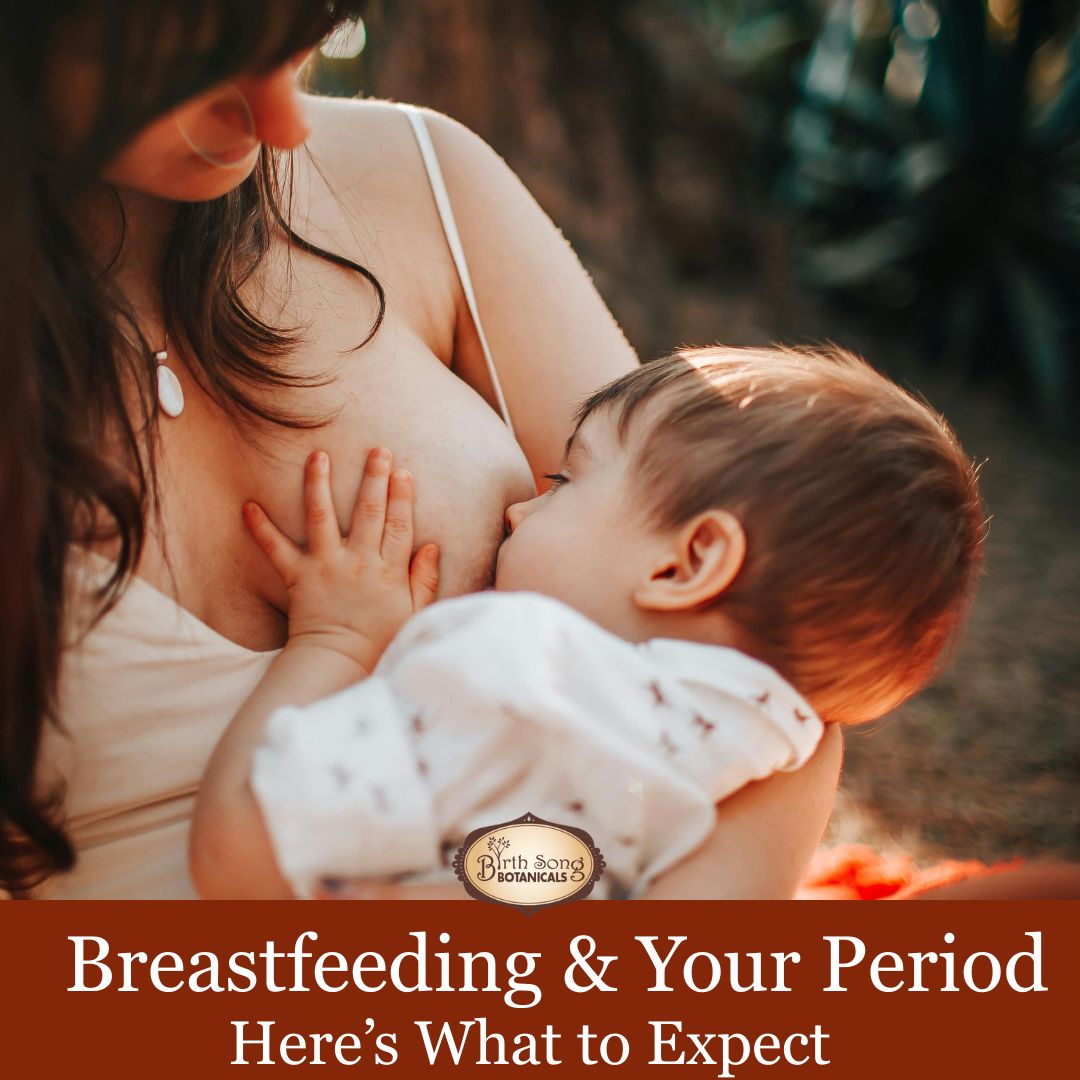Balancing Hormones with Seed Cycling

Join me as we dive in and discover seed cycling for hormonal balance and fertility support. Learn about the seeds involved, their impact on hormone balance, and seamlessly integrate this practice into your daily routine.
Are you familiar with seed cycling?
Seed cycling along with Moon Syncing is becoming more popular and for good reason because we are seeing significant promise in supporting hormonal and menstrual health, is a concern increasingly prevalent among women today.
The intricate web of women's hormones operates in a delicate equilibrium, profoundly influenced by various factors such as diet, exercise, sleep, stress levels, environmental toxins, and herbs. Any disruption among these elements can perturb this delicate balance, potentially leading to a range of health issues including irregular periods, acne, PCOS, thyroid disorders, chronic fatigue, stress and anxiety.
Seed cycling is emerging on the women's health scene as a simple and effective means to gently support hormone levels. It aids in maintaining hormonal balance, alleviating PMS symptoms, enhancing fertility, and potentially stimulating menstruation in cases of absence (amenorrhea).
While not a panacea on its own, consistent incorporation of seed cycling in your diet, combined with other hormone-stabilizing practices such as Qigong, yoga, and mediation, seed cycling harnesses the healing potential of food and herbs.
Let's dive deeper into the world of seed cycling to understand its nuances and seamlessly integrate it into your daily life affirming practices.

UNDERSTANDING SEED CYCLING
Seed cycling involves consuming specific seeds during the two primary phases of your menstrual cycle—follicular and luteal—to facilitate a healthy balance between estrogen and progesterone levels. This gentle, natural approach can mitigate PMS symptoms, promote fertility, aid in menstruation induction for amenorrhea, and address various symptoms linked to hormonal imbalances.
This practice is adaptable to all stages of a woman's life, including post-menopause. However, it proves particularly advantageous for those discontinuing hormonal birth control or experiencing post-birth control syndrome symptoms like acne, irregular or absent periods, and PMS.
DECODING YOUR MENSTRUAL CYCLE
To comprehend seed cycling, it's crucial to grasp the two main phases of your menstrual cycle:
- Follicular Phase: Initiating from the first day of menstrual bleeding until ovulation (lasting roughly 14 days).
- Luteal Phase: Extending from ovulation until the subsequent menstrual bleeding (also around 14 days on average).
Learn to track your menstrual cycle here.
In a balanced hormonal scenario, estrogen ascends in the first half of the cycle, while progesterone gains momentum in the latter half, accompanied by a gradual decline in estrogen. An imbalance between these hormones can contribute to a spectrum of issues, including PMS, menstrual cramps, acne, short luteal phases, irregular cycles, and amenorrhea.
STARTING SEED CYCLING FOR HORMONAL BALANCE
Seed cycling is a straightforward and simple process. During the follicular phase, integrate 1-2 tablespoons of ground flax and pumpkin seeds into your daily intake. After ovulation, shift to 1-2 tablespoons of ground sunflower and sesame seeds throughout your luteal phase.
If your menstrual cycle doesn't align with the standard 28-day cycle, don't worry! Many women have varying cycle lengths. Staying aligned with the 14-day rotation for each seed phase ensures the process nudges your body toward an optimal menstrual cycle rhythm, aiding in realignment.

ADDRESSING IRREGULAR OR MISSING PERIODS (AMENORRHEA)
For those with irregular or absent periods, incorporating seed cycling remains feasible. Rather than syncing with your menstrual cycle phases, adhere to moon phases as a general guideline:
- Days 1-14 (new moon to full moon): Consume pumpkin and flax seeds.
- Days 15-28 (full moon to new moon): Integrate sunflower and sesame seeds.
While associating with lunar phases might seem metaphysical rather than scientific, consider this- the moon exerts substantial influence—it governs oceanic tides, affects gravitational pull, and potentially impacts your menstrual cycle. Notably, both the moon's phases and the average menstrual cycle span 28 days, a correlation not merely coincidental. Many women's cycles, when balanced, align naturally with lunar phases.
HOW SEED CYCLING SUPPORTS HORMONE BALANCE
Despite limited scientific research directly supporting the correlation between seed cycling and improved hormonal balance in women, it's essential to keep an open mind regarding nutrition and natural healing practices due to research limitations and the scarcity of studies on specific topics. Just because it hasn't been studied (yet) it doesn't mean it seed cycling isn't a valid practice. While direct studies linking seed cycling to hormone balance are lacking, there are observable correlations suggesting that specific nutritional components in flax, pumpkin, sesame, and sunflower seeds might contribute to supporting your natural hormonal cycle.

FOLLICULAR PHASE
In the initial phase of the menstrual cycle (follicular phase), pumpkin seeds and flax seeds aid in enhancing estrogen levels while preventing excess estrogen. Flax seeds contain lignans, binding to surplus estrogen, while pumpkin seeds, rich in zinc, support progesterone production as you approach the rise of progesterone in the cycle's second phase.
LUTEAL PHASE
During the latter part of your cycle (luteal phase), sesame seeds and sunflower seeds play a role in boosting progesterone production. Sesame seeds, abundant in zinc, aid in enhancing progesterone production and contain lignans that block excess estrogen as progesterone levels increase. Sunflower seeds, high in vitamin E and selenium, contribute by boosting progesterone levels and supporting estrogen detoxification in the liver during the luteal phase.

NUTRITIONAL COMPONENTS IN SEEDS
LIGNANS
Flax and sesame seeds are rich in lignans, compounds with weak estrogen-like effects in the body, naturally supporting healthy estrogen production. Research indicates that flax seeds can lengthen the luteal phase, improve ovulation, and alleviate common PMS symptoms such as breast pain and cramping.
ZINC
Pumpkin and sesame seeds, both high in zinc, contribute to the formation of the corpus luteum in the uterus, responsible for progesterone production and preparing the uterus for potential implantation.
OMEGA-3S, OMEGA-6S + VITAMIN E
Flax and pumpkin seeds, abundant in omega-3 fatty acids and vitamin E, support blood flow to the uterus, increase progesterone secretion, and aid in maintaining healthy cell membranes, potentially reducing PMS symptoms.
SELENIUM
Sunflower seeds, rich in selenium, aid in estrogen detoxification, reducing excess estrogen levels during the luteal phase.
INCORPORATING SEED CYCLING INTO YOUR ROUTINE
It's recommended to consume 1-2 tablespoons of specific seeds daily, preferably raw and ground, especially for flax and sesame seeds. Incorporating these seeds into your diet creatively—adding them to smoothies, yogurt, oatmeal, salads, or homemade granola—provides versatile ways to benefit from seed cycling.
TIMEFRAME AND CONSIDERATIONS
Seed cycling requires time to harmonize with your body, typically taking at least three months of consistent daily use to notice benefits. Keeping a journal to track symptoms monthly helps identify changes over time.
Regarding continuity, it's a personal choice. Seed cycling offers an easy, gentle daily method to naturally support hormone balance. While initially daunting, habitualizing it can make it second nature. Considering it month-by-month sets achievable goals.

PREPARATION TIPS AND ADDITIONAL NOTES
Grinding or chopping seeds, particularly flax and sesame, aids in digestion. Opting for raw seeds ensures nutrient integrity. Storing seeds in the fridge or freezer prevents their quick spoilage due to their unsaturated fats. Tracking your unique cycle remains essential, preferably through methods like basal body temperature monitoring.
While seed cycling holds promise, it's not a standalone solution for hormone imbalances. Prioritizing factors like good sleep, stress management, balanced diet, hydration, working with herbal supplements, and minimizing exposure to hormone-disrupting toxins is crucial for comprehensive hormone health.
In closing, I hope you enjoy this simple and nourishing practice to harmonize your menstrual cycle. Remember it is important to seek guidance from a healthcare provider to test hormone levels and diagnose conditions. From there, collaborating with a dietitian or a holistic health coach, will help you implement dietary and lifestyle changes that support your as you to balance and maintain optimal hormone levels so you thrive!
And if you are looking for herbal teas and tinctures to support hormone balance check out:
- Woman's Balance Herbal Tea for women's wellness
- Menstrual Harmony tincture to regulate an irregular cycle
- Fertile Ground tincture to prepare for pregnancy
- Cycle Relief tincture for painful menstrual cramp relief
- Solid and Serene for stress and anxiety support
- Yoni Steam Collection to honor your feminine temple
Want More?!? Check these out!
Herbal Products for PMS:
Blog Posts:
- 7 Common Causes of Period Spotting
- How to Enjoy Your Period
- Four Ways to Increase Fertility Naturally
- Herbal Remedies for Heavy Period Bleeding in Perimenopause
- When Will My Menstrual Cycle Return After Having a Baby
- What You Should Know About PCOS
- Tracking Your Cycle: With The Fertility Awareness Method
- How to Plan or Prevent Pregnancy
- Menstrual Cycle Syncing with Moon Phases, Herbs and Qigong
- Harnessing the Power of Mugwort and the Moon
- Balancing Hormones with Seed Cycling
- The Incredible Benefits of Shatavari for Women’s Health
- Yoni Steam- The Sacred Origin, The Herbs, and How To Steam
- Womb Food Eat These Four Foods To Improve Your Uterine Health
- Natural Remedies for Bacterial Vaginosis BV
- Black Cohosh for Hot Flashes in Menopause
- Natural Ways to Boost Testosterone In Women During Perimenopause and Menopause
- Botanica Erotica: Exploring Sensuality and Aphrodisiac Herbs
- Treating a Urinary or Bladder Infection Naturally: An Informative Guide
- A Woman's Guide to Uterine Fibroids
- Herbs for Hot Flashes in Menopause
- St. John's Wort: For First Aid, Nerve Pain, and Mood Support
Remember to:
Like our Birth Song Botanicals Facebook Page
Follow Birth Song Botanicals Co. on Instagram
Read our Birth Song Botanicals Blog
Watch Birth Song Botanicals on Youtube
Listen to Birth Song Botanicals on SoundCloud
Be inspired by Birth Song Botanicals on Pinterest





